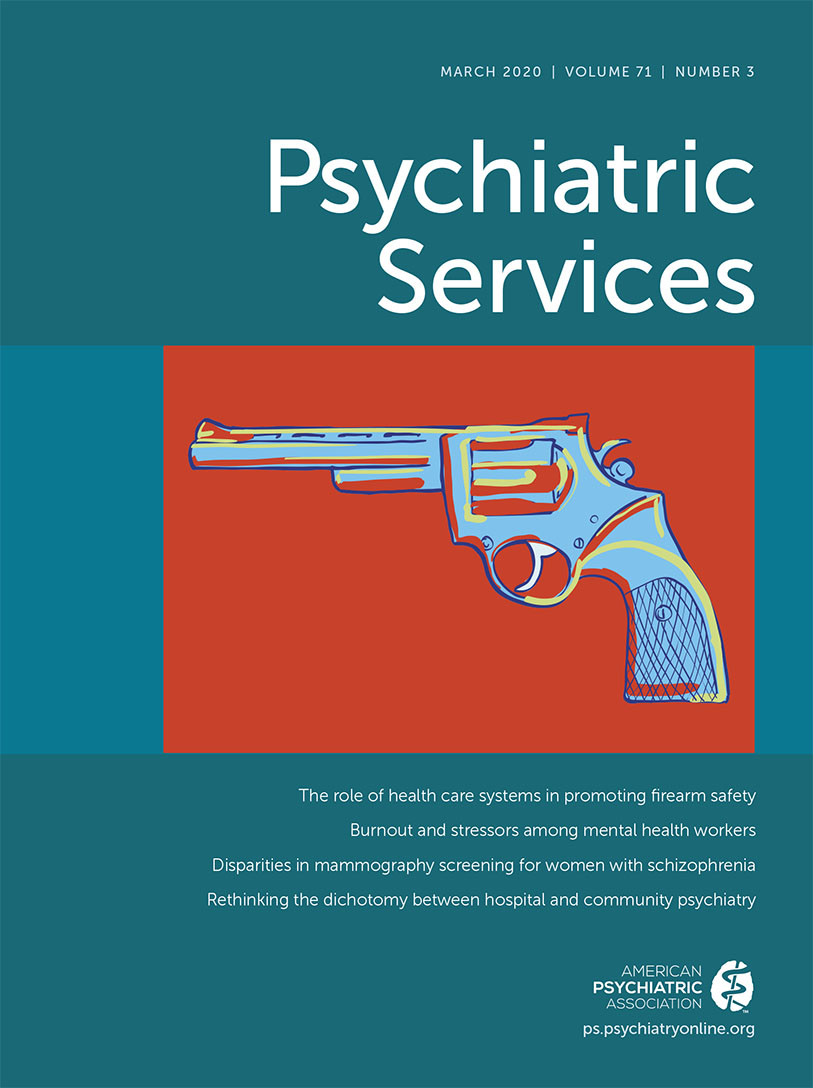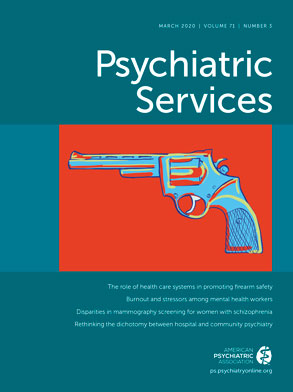Workplace violence toward health care practitioners may contribute to their levels of burnout (
1,
2). This phenomenon is widespread: in 2015 the U.S. Bureau of Labor Statistics stated that nonfatal injuries due to aggression were approximately three times more frequent among health care practitioners than among private industry workers, with a reported incidence of 14 per 100,000 people per year. Similarly, a recent Italian study showed that 45% of health care professionals had experienced physical or verbal aggression from patients or patients’ relatives (
3). Italy has a universal public mental health care system, which gives patients direct access to care, potentially increasing their perceptions that the system functions well. Unfortunately, a significant reduction in the number of mental health care workers in Italy due to retirement has led to worsening quality of services because of decreased time that can be dedicated to patients. These conditions could in part explain the increasing number of aggressive acts (
4).
The Violence Prevention Alliance, a network of World Health Organization member states, defines violence as “the intentional use of physical force or power, threatened or actual, against oneself, another person, or against a group or community, that either results in or has a high likelihood of resulting in injury, death, psychological harm, maldevelopment, or deprivation.” This definition distinguishes four kinds of violent behavior: physical, sexual, and psychological attacks, and deprivation (
5).
Being the victim of aggressive behavior may increase an individual’s level of burnout, a state characterized by physical and mental exhaustion as well as detachment and negative attitudes toward work, accompanied by a perception of diminished professional efficacy (
6). Professional burnout negatively affects both health care professionals and patients. High levels of burnout have been detected among mental health practitioners, but few studies have examined whether it is associated with workplace violence (
7). Thus, the aim of this study was to explore the association between workplace violence and burnout among mental health workers and to assess whether individual or workplace characteristics could influence that relationship.
Methods
A cross-sectional survey was conducted among mental health professionals working in emergency psychiatric wards in IRCCS Ospedale Policlinico San Martino in Genoa, San Luigi Gonzaga Hospital of Orbassano, and Gaspare Rodolico Hospital in Catania—and in mental health centers in Genoa and Catania, Italy, between January 1 and December 31, 2018. We developed an ad-hoc structured questionnaire to assess workplace violence among mental health professionals. The questionnaire inquired about the frequency and modality of exposure to violent behaviors from patients or their relatives. It included questions on verbal threats; verbal, physical, and object aggressions; and symptoms experienced after the worst event, including insomnia, anorexia, flashbacks, and discomfort.
Participation in the study was offered to all employees of the health centers listed above: 320 employees, including psychiatrists, residents in psychiatry, nurses, and other mental health professionals. Two hundred fifteen questionnaires were returned (67%). A total of 32 questionnaires were excluded because of incomplete data, resulting in a final sample of 183 participants. Burnout was assessed by using the Maslach Burnout Inventory (MBI), a 22-item self-report questionnaire that examines three dimensions: emotional exhaustion, depersonalization, and personal accomplishment (
8). MBI scores range from 0 to 132, with higher scores indicating a greater degree of burnout. The study was approved by the IRCCS Ospedale Policlinico San Martino review board; all participants provided written informed consent.
First, we compared sociodemographic data, workplace characteristics, history of aggression, and levels of burnout among four categories of professionals: psychiatrists, residents, nurses, and other mental health professionals. We sought to explore the main correlates of burnout, using total MBI score as the main outcome. We conducted univariate analyses (Pearson product-moment correlation, t test, and one-way ANOVA) to explore associations between MBI scores and variables related to workplace aggression and sociodemographic and work-related factors. In addition, we sought to examine whether individual characteristics (age, gender, years of work experience, workplace, and previous training on violence management) would affect the strength of the association between workplace violence and burnout. Moderator effects were examined with the PROCESS macro (2.12.1 release), a widely used regression-based approach that probes the interaction between predictor and moderator (
9). The macro provides bias-corrected 95% confidence intervals by using bootstrap calculation. SPSS 22.0 was used for all analyses, and the level of significance was set at p<0.05.
Results
Among psychiatric residents (N=58, 32%), mean±SD age (29.8±3.2 years, p<0.001) and the percentage who had more than 10 years of working experience (2%, p<0.001) were significantly lower than for all other professional categories (
Table 1). Forty-eight percent of residents received specific training for managing aggression in the workplace. A total of 67% were working in acute inpatient psychiatric units, 31% in university psychiatric units, and 2% in private institutions. Among nurses (N=56, 31%) mean age was 50.5±19.0 years, 60% were women, and 76% had more than 10 years of working experience. Forty-eight percent of nurses were working in acute inpatient psychiatric units, 38% in university psychiatric units, and 14% in mental health centers. A total of 65% of nurses received specific training for managing workplace aggression.
The mean age of other professionals (rehabilitation technicians, psychologists, and educators) (N=30, 16%) was 49.0±12.0 years, 67% were women, 67% had more than 10 years of working experience, and 50% underwent specific training on workplace violence. A majority (42%) were employed in acute inpatient psychiatric units, 21% in university psychiatric units, 30% in mental health centers, and 6% in private institutions.
Data on workplace violence are reported according to the time frame of occurrence, separated into two categories: aggressions over the course of a whole career (“lifetime”) and episodes that occurred in the past year. A majority of professionals (N=164, 90%) reported having experienced verbal aggression from patients or patients’ relatives, with no differences among the professional groups studied. Verbal threats were reported by 97 participants (53%), and aggression with objects was even more frequent (N=150, 82%). Both verbal threats (p=0.03) and object aggression (p=0.03) were more frequently experienced by psychiatrists than by residents, nurses, and other professionals. Physical aggression was reported by half of participants (N=92, 50%), with a similar prevalence across professional categories.
Considering episodes of violence experienced in the past year, the prevalence of verbal aggression (N=76, 42%) and of object aggression (N=81, 44%) were similar in the total sample, while the frequency of physical aggression was much lower (N=5, 3%) and was experienced only by nurses and other professionals. Regarding between-group differences,
Table 1 shows that psychiatrists, residents, and nurses reported a higher frequency of verbal aggression than did other professionals (p=0.04), while object aggression was more frequently reported by psychiatrists compared with residents and more frequently reported by nurses compared with other professionals (p=0.04).
Among psychiatrists and residents, the mean numbers of symptoms experienced after the first episode of workplace violence were 0.8±1.2 and 0.8±1.2, respectively, while nurses and other professionals reported a mean of 0.5±0.9 and 0.2±0.5, respectively (p=0.02). No differences among groups were observed in the number of symptoms occurring up to four weeks after the most recent episode.
Overall MBI scores suggested low to moderate levels of burnout (mean≈40). No significant difference was found between the subgroups in total or subscale scores. Furthermore, we did not detect significant associations between total MBI score and gender (p=0.71), age (p=0.58), longer working experience (p=0.81), or having received specific training on workplace violence (p=0.83). A significant difference was found in total MBI score according to workplace, with higher scores among professionals working in acute inpatient psychiatric units versus those in university psychiatric units (45.5±16.9 versus 37.8±13.1, p=0.01).
No between-group differences in MBI scores were detected in relation to differences in rates of lifetime verbal aggression, verbal threats, object aggression, or physical aggression. Individuals who were exposed to verbal aggression or object aggression in the previous year had significantly higher MBI scores than those who were not exposed (44.5±15.6 vs. 38.1±14.1, p=0.003; and 43.5±16.5 vs. 38.6±13.3, p=0.03, respectively). No differences in MBI score were found on the basis of exposure to physical aggression in the previous year (p=0.97).
Total MBI score correlated significantly with the number of symptoms experienced by practitioners immediately after the worst episode they experienced (Spearman’s rho=0.15, p=0.04) but not with the number of symptoms they developed later (rho=0.11, p=0.13).
Factors that were significantly associated with MBI score at the univariate level were entered in a stepwise linear regression (F=6.92; df=4, 18; p<0.001; R2=13.5%). Total MBI score was positively associated with having experienced verbal aggression in the past year and with the number of symptoms experienced immediately after the event, although it was negatively associated with working in a university clinic.
Participant age, years of work experience, workplace, and training were not effect modifiers of the association between verbal aggression and burnout, while gender was a significant moderator, which improved the model (R2 change=4%, F=6.77; df=1, 18; p=0.01). In particular, verbal aggressions in the past year were strongly associated with higher levels of burnout among women (effect=11.3, 95% confidence interval=4.65 to 18.0, t=3.4, p=0.001, R2=13%), but the association was not significant among men.
Discussion
Workplace aggression was extremely common among mental health professionals in our sample, in line with the findings of other authors (
10). Nonetheless, according to the norms of burnout for mental health practitioners in Italy, the mean scores obtained in our sample on the emotional exhaustion, depersonalization, and personal accomplishment subscales were all within the normal range across all professional categories (
11). Symptoms occurring after the episode of aggression were only weakly associated with current levels of burnout. On the other hand, working in a university clinic predicted lower levels of burnout, possibly because this setting experiences less-frequent compulsory admissions and participants from university clinics have a lower mean age. Lack of a substantial effect of violence on burnout may be due to the fact that the MBI assesses the experience of participants but does not observe how burnout changes over time; it could be argued, thus, that the detrimental effects of experiencing aggression could have waned over time without being detected by the current survey. Workplace violence has been recognized as hindering professionals’ well-being, organizational efficiency and, eventually, patient care (
12,
13). Assessing the prevalence of physical and verbal aggression toward mental health professionals could represent the first step in implementing guidelines and preventive measures to face workplace violence and its consequences.
Several limitations of this study should be acknowledged. The main limitation was the use of a newly developed questionnaire that has not been formally validated against objective measures of aggression. This questionnaire was used mainly because, to our knowledge, other assessment tools were not available. In addition, given the retrospective nature of the collected data and the sensitive issue being studied, recall bias can be expected, especially when participants were asked to recall experiences from throughout their whole careers. Professionals who experience higher levels of burnout may have a greater tendency to emphasize past episodes of aggression (i.e., reverse causality). Furthermore, the number and dates of violent episodes were not recorded, making it impossible to examine the cumulative effects of repeated aggressions and the temporal relationship with burnout. The sample was relatively small, and some associations may have gone undetected because of low statistical power. We also did not record other factors that may have contributed to increased levels of burnout, such as specific organizational features or individual workload. Finally, we did not employ techniques to handle missing data, such as multiple imputation.

